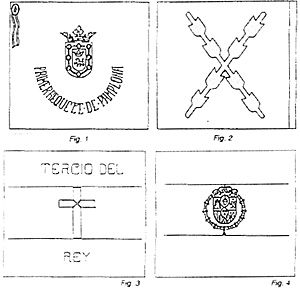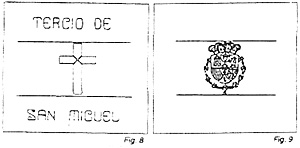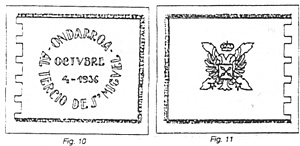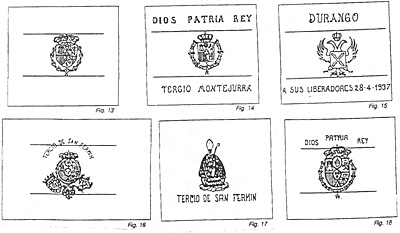 This article is taken mostly from a previous work by F.J. de Lizarza, published in the Spanish carlist magazine "Aportes" (almost impossible to find nowadays), and from J. Arostegui's work "Los combatientes carlistas en la Guerra Civil Espanola" Colour photos of some of these flags can be seen in this latter two-volume book.
This article is taken mostly from a previous work by F.J. de Lizarza, published in the Spanish carlist magazine "Aportes" (almost impossible to find nowadays), and from J. Arostegui's work "Los combatientes carlistas en la Guerra Civil Espanola" Colour photos of some of these flags can be seen in this latter two-volume book.
Most of you have seen the red "St. Andrew" cross or Borgona [ burgundy ] cross as the only carlist flag. Well, it's time to add some colour cloth to your catholic red berets.
Two requetes (companies) of the Tercio de Pamplona were part of Garcia Escamez column from July 19th 1936. The first Company (246 men) were attached to the 7th Btn. of regimiento de America n° 23. This unit used a 87x93 cm flag as per fig. n° 1. Light golden coloured cloth, it had a Pamplona badge and the words "Primer Requete de Pamplona" gold written. the other side on a silver cloth depicted a dark red Borgona cross (fig n° 2).
Tercio del Rey.
Following the Somosierra fight on July 25th, this unit became the new "Tercio del Rey" which waved the classic 113x140 cm. spanish royal bicolour flag (red/yellow/red). On one side (fig n° 3) with a black and golden lined latin cross on the wider yellow central line, and under and above it had written the words "TERCIO DEL REY" in black and yellow colour. At the reverse side, and on its centre, the royal badge circled by the "Toison de Oro Order".
 Tercio de Navarra n° 1.
Tercio de Navarra n° 1.
This unit left Pamplona on July 20th towards vera del Bidasoa, and was very active in the North, teruel and Extremadura campaigns. The figure depicts the 2nd company standard (fig n° 5 & 6). A white cloth 112x140 cm. One side is completely white meanwhile the other had a black (with grey and white light) the empire two-headed eagle, fingers and beak in gold, and red tongues. On its chest a shield with the Borgona cross in red. Below the eagle the words "2' COMPANLA" in black outlined in gold. On the eagle it was read "TERCIO DE NAVARRA". As a curiosity the eagle's legs resemble a duck or palmiped bird.
Tercio de Navarra n° 2
Also known as "Tercio de Lacar" as a homage to a carlist victory in 1875 in the former "spanish civil wars". The unit left Pamplona on the 21st towards Vera de Bidasoa, being its 3rd Company the first nationalist unit entering into San Sebastian . Saw action in the North, Teruel, Maestrazgo, and Ebro campaigns as well in the Catalonia fall. This flag is a bicolour 112x140 cm. being its central stripe 3%5 sized than the other two stripes. In one side it is just an average nationalist spanish flag (red/yellow/red) , and at the other side at its outer side the Borgofia cross, in the middle the words "TERCIO DE LACAR" and at the inner side of the flag Navarra's coat of arms, over a small star and encircled by a laurel diadem.

Tercio de San Miguel or 4th of Navarra.
Also known as "4° de Navarra", had in its ranks both navarrese and Guipuzcoans (basque) carlists. We know at least two flags.
The former 115x150 cms. (figs. 8 & 9) follows the same pattern as in "Tercio del Rey", i.e. the latin cross (light blue this time) and the name, and at its reverse the badge or coat of arms. In this latter we can see a "Corazon de Jesus" (Jesuschrist heart) with a thorns crown, two golden thunderbolts and a red and yellowish flame under a small cross
 The second flag, probably a present or for ceremonial activities, is a cloth 85x94 cms., one side in a purple red (fig 10), with golden words "ONDARROA- AL TERCIO DE SAN MIGUEL" encircling "OCTUBRE 41.936". White at the other side (fig. 11), with a Borgona cross and over it a crowned two-headed eagle with a silver badge outlined gold. This unit saw active action in the North campaign, Brunete battle, and in the advance against Barcelona.
The second flag, probably a present or for ceremonial activities, is a cloth 85x94 cms., one side in a purple red (fig 10), with golden words "ONDARROA- AL TERCIO DE SAN MIGUEL" encircling "OCTUBRE 41.936". White at the other side (fig. 11), with a Borgona cross and over it a crowned two-headed eagle with a silver badge outlined gold. This unit saw active action in the North campaign, Brunete battle, and in the advance against Barcelona.
 Tercio de Abarzuza.
Tercio de Abarzuza.
The flag of this unit follows the same pattern as those described for Tercio del rev and Tercio de San Miguel. Size was 112x150 cms. and the cross is black.
Tercio de Montejurra.
Also known as "9° de Navarra", fought alongside with Tercio de Lacar (1st Brigade, 1st Navarra Division, Maestrazgo Army Corp) in the same campaigns. we know two flags of this unit. The former, as previous flags, a 114x146 cms. with a a black latin cross outlined in gold and the name of the unit, and at its reverse, the spanish badge with a "detente" (Jesuschrist heart used as a bullet protection).
 The other one, given as a present by the village of Durango is a Nationalist royal bicolour flag ( redl'yellow/red) with its central stripe doubled width In its centre the spanish badge with the "Holy Jesuschrist heart" encircled by an open collar. Golden words "DIOS, PATRIA, REY" (God, motherland, king) and "TERCIO DE MONTEJURRA". At the other side the two-headed eagle with a similar badge as above description, outlined in gold and the sentence "DURANGO A SUS LIBERADORES 28-4-1.937" also in gold.
The other one, given as a present by the village of Durango is a Nationalist royal bicolour flag ( redl'yellow/red) with its central stripe doubled width In its centre the spanish badge with the "Holy Jesuschrist heart" encircled by an open collar. Golden words "DIOS, PATRIA, REY" (God, motherland, king) and "TERCIO DE MONTEJURRA". At the other side the two-headed eagle with a similar badge as above description, outlined in gold and the sentence "DURANGO A SUS LIBERADORES 28-4-1.937" also in gold.
Tercio de San Fermin.
This unit was created in 1937 and saw action in the North campaign against Vizcaya. Due to the high number of casualties, it melted into the Tercio de Lacar. the cmbat flag follows the same pattern as the other ones. being its size 118x144 cms.
A second ceremonial flag, 180x263 cms is a royal bicolour (fig. 16) with a round spanish badge, surrounded by Pamplona and the Requette ones, and plain red/yellow/red at its reverse. The unit name is written in silver.
Finally a third standard or banner 55x70 cms (figs. 17 & 18). it has on one side a golden colour and a San Fermin image (a catholic bishop), with a purple and gold dress over grey clouds. Written with golden words "TERCIO DE SAN FERMIN". The reverse is a royal bicolour spanish flag with the spanish badge and silver "Holy Jesus Christ heart". Written "DIOS, PATRIA, REY" in gold.
Back to Abanderado Vol. 6 No. 3/4 Table of Contents
Back to Abanderado List of Issues
Back to MagWeb Master Magazine List
© Copyright 2003 by Rolfe Hedges
This article appears in MagWeb.com (Magazine Web) on the Internet World Wide Web. Other articles from military history and related magazines are available at http://www.magweb.com